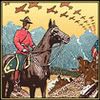Two things a screenwriter needs to learn, two skills that separate and define what we do from what other writers do, are telling a story visually and leaving enough white space for the other crafts involved to do their work.
Studies show that 90% of what an audience takes on board from a film or TV show comes through the eyes. Only 10% of what they retain or remember is as a result of what they hear.
Try this yourself.
Quote your ten favorite movie lines in two minutes. Too hard? Okay. Try to do it in five minutes. Hell, give yourself ten. Only the rarest of Cinephiles can accomplish the task -- and most of them still get the lines wrong.
Bogart never said, "Play it again, Sam!" No Mexican bandit ever taunted, "Badges? We don't need no stinkin' badges!"
"May the Force be with you." Nope.
"Luke, I am your father." Uh-uh.
"Beam me up, Scotty." Never happened.
"Do you feel lucky, Punk?" Not even close.
"If you build it, they will come." I'm afraid not.
"Life is like a box of chocolates." No.
"Greed is good." Close but no cigar.
Sorry to say, most of those tasty bon mots you're crafting are going to be half heard at best and mangled by even your most ardent fans.
So, I'm saying you should spend your time detailing the wallpaper, emphasizing the parentheticals and indicating what's a wide shot and when we're in close-up?
Not if you want any self-respecting and therefore probably talented production designer, actor or director to help bring your script to life. The first thing each of them is going to do is take a thick Sharpie to those passages.
So what's left...?
What's left is what needs to be in each scene to tell your story.
When an audience first encounters a movie or TV show, they're mostly a blank slate. Of course, the marketing has given them an idea of what's going to be offered -- horror, a mystery, some laughs -- that's why they're there.
Where they go next and how your director, crew and cast get them there is what's in the map we call a screenplay. Everything that comes into their field of vision must be there for a reason. An emotional reason. An intellectual reason. A calculated reason. Every moment you spend with a particular character or in a particular place or looking at a particular object has to be important to the story.
Joseph Conrad got it right long before he ever saw a movie, "My job is to make you see."
I'm a firm believer that a lot of what's wrong with movies -- the sameness and the sequels and the predictability, comes from the people who make them trying too hard to make sure the audience DOESN'T see.
I like "Crank" and "Wanted" as much as the next guy, but they're not art or even good stories and I'd bet their makers would be the first to admit that. They're just the newest thrill rides and examples of all the shock and awe that advances in movie tech can deliver.
And somewhere in the process of developing and using those techniques, a lot of filmmakers realized that you could hide what was less good, less than figured out and less than finished simply by not showing it.
Smash cutting and wavy cam can pump the adrenaline and keep the audience guessing, but you only need to do stuff like that if what you're making has no other way of engaging them.
False impressions and false emotions still feel real in the moment. It's only later that you begin to feel you were cheated.
Whether the camera is careening around the "Flashpoint" squad room or flash frame images are all that's visible in the "CSI" lab, what's really happening is that I'm being fed style over substance. Nothing wrong with that, of course. Same as there's nothing wrong with a Big Mac or Chrysler Minivan.
But it all just makes me wonder if the artists working on those shows are really as good as their network publicists say. And if they are, why does nobody want me to see what they can really do?
How come so much that's out there right now is so obviously made in the cutting room? Does it mean the scripts weren't all that special to begin with, or the people executing them weren't very good -- or both?
Maybe I'm really old fashioned, but when I see a moving master, a seamless tracking shot or a locked off monologue, I know I'm in the hands of people who want me inside the frame with their story, not pushed far enough away that I can't see how the magic's done.
They want me to see the truths they're offering. They're confident that the story works and the characters are believable. They trust that they can hold my attention to the next commercial -- and maybe even beyond it.
Only a true story teller can fill completely viewable frames with meaning. And only when an audience can depart from the experience with some meaning of their own, whatever that may be for them -- only then has the screenwriter done his job.
Here's something slow. Take whatever meaning from these images that you will. Just be aware of how much you're being asked and allowed to see. And enjoy your Sunday.
New York 2008 from Vicente Sahuc on Vimeo.
Subscribe to:
Post Comments (Atom)




1 comment:
Bon Mot? Now there's a phrase that doesn't get enough use these days! Or have I been reading too much Wodehouse?
Andrew Culture
(my siggy)
Badges are my thing...
Photos are also my thing...
My good living/ eating blog...
Writing random stuff is also my thing...
Post a Comment